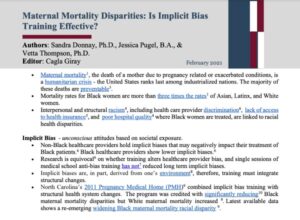Maternal Mortality Disparities: Is Implicit Bias Training Effective?
Sandra Donnay, Ph.D., Jessica Pugel, B.A., & Vetta Thompson, Ph.D.
February 2021
- Maternal mortality1, the death of a mother due to pregnancy related or exacerbated conditions, is a humanitarian crisis – the United States ranks last among industrialized nations. The majority of these deaths are preventable3.
- Mortality rates for Black women are more than three times the rates1 of Asian, Latinx, and White women.
- Interpersonal and structural racism4, including health care provider discrimination6, lack of access to health insurance5, and poor hospital quality4 where Black women are treated, are linked to racial health disparities.
Implicit Bias – unconscious attitudes based on societal exposure.
• Non-Black healthcare providers hold implicit biases that may negatively impact their treatment of Black patients.6 Black healthcare providers show lower implicit biases.6
• Research is equivocal6 on whether training alters healthcare provider bias, and single sessions of medical school anti-bias training has not7 reduced long term implicit biases.
• Implicit biases are, in part, derived from one’s environment8 , therefore, training must integrate structural changes.
• North Carolina’s 2011 Pregnancy Medical Home (PMH) 9 combined implicit bias training with structural health system changes. The program was credited with significantly reducing10 Black maternal mortality disparities but White maternal mortality increased9 . Latest available data shows a re-emerging widening Black maternal mortality racial disparity9.
Policy Recommendations
Implicit bias interventions must target multiple levels of determinants4 of racial disparities addressing the interaction of health care systems, workers, and patients.
- Improve Data Collection: Aggregate and disseminate data from large Health-Care systems’ Integrated Delivery Networks11. Expand state level Maternal Mortality Review Committees3 .
- Address Disparate Hospital Quality: Bundles5 , evidence-based protocols that standardize treatment, and suitable for rural and urban environments, should be nationally implemented. Data form MMRCs can be used to generate localized Bundles and for continuous monitoring to assure maintenance of gains and improvement in outcomes.
- Improve Healthcare Access: Medicaid expansion5 under the Affordable Care Act (ACA) in states with large Black populations and Medicaid extension5 must be prioritized.
- Fund Research on Innovative Care Models: Group Prenatal Care (GPC) shows promise in improving maternal health behaviors13. Doula – supported women have fewer delivery complications12. Research support is needed to ascertain their effectiveness on mortality outcomes.
- Diversify Health Care Professionals: National and state initiatives to develop and train Black physicians and other healthcare workers must be implemented.
Additional Resources
- Center for Disease Control and Prevention (2020). Pregnancy Mortality Surveillance System. Pregnancy Related Mortality by Race/Ethnicity 2014-2017. Retrieved January 21, 2021, from: https://www.cdc.gov/reproductivehealth/maternal-mortality/pregnancy-mortality-surveillancesystem.htm?CDC_AA_refVal=https%3A%2F%2Fwww.cdc.gov%2Freproductivehealth%2Fmaternalinfanthealth%2Fpregnan cy-mortality-surveillance-system.htm
- Roeder, A. (2019). America Is Failing its Black Mothers. Harvard Public Health Magazine. Retrieved December 8, 2020, from: https://www.hsph.harvard.edu/magazine/magazine_article/america-is-failing-its-black-mothers/
- Center for Disease Control and Prevention (2020). Enhancing Reviews and Surveillance to Eliminate Maternal Mortality (ERASE MM). Retrieved December 8, 2020, from: https://www.cdc.gov/reproductivehealth/maternal-mortality/erasemm/index.html
- Howell, E. A. (2018). Reducing disparities in severe maternal morbidity and mortality. Clinical Obstetrics and Gynecology, 61, 387-399. 10.1097/GRF.0000000000000349
- Villavicencio, J.C., Mctligh, K.W., & Edmonds, B.T. (2020). Overview of U.S. Maternal Mortality Policy, Clinical Therapeutics, 42, 408-418. https://doi.org/10.1016/j.clinthera.2020.01.015
- Maina, I.W., Belton, T.D., Ginzberg, S., Singh, A., & Johnson, T.J., (2018). A decade of studying implicit racial/ethnic bias in healthcare providers using the implicit association test. Social Science & Medicine, 199, 219-229. DOI: 10.1016/j.socscimed.2017.05.009.
- Cristina M. Gonzalez, Mimi Y. Kim & Paul R. Marantz (2014). Implicit Bias and Its Relation to Health Disparities: A Teaching Program and Survey of Medical Students, Teaching and Learning in Medicine, 26, 64-71. doi: 10.1080/10401334.2013.857341.
- Vuletich, H.A., & Payne, B.K., Stability and change in implicit bias. (2019). Association for Psychological Science, 30, 854- 862. doi: 10.1177/0956797619844270.
- North Carolina Department ofHealth and Human Services State Center for Health Statistics (2019). Maternal Mortality/Morbidity Data. Retrieved January 21, 2021 from: https://www.cdc.gov/reproductivehealth/maternal- mortality/pregnancy-mortality-surveillance- system.htm?CDC_AA_refVal=https%3A%2F%2Fwww.cdc.gov%2Freproductivehealth%2Fmaternalinfanthealth%2Fpregnan cy-mortality-surveillance-system.htm.
- Belluz, J. (2017). Black moms die in childbirth at 3 times the rate of white moms. Except in North Carolina. Retrieved 12.16.20 from: https://www.vox.com/health-care/2017/7/3/15886892/black-white-moms-die-childbirth-north-carolina-less.
- Penner, A.L., Blair, I.V., Albrecht, T.L., & Dovidio, J.F. (2014). Reducing racial health care disparities: A social psychological analysis. Health and Well-Being, 1, 204-212DOI10.1177/2372732214548430.
- Steel, A. Frawley, Jane, Adams, J., & Diezel, H. (2015). Trained or professional doulas in the support and care of pregnant and birthing women: a critical integrative review, Health and Social Care in the Community, 23, 225-241. doi: 10.1111/hsc.12112.
- Byerley, B.M. & Haas, D.M. (2017). A systemic overview of the literature regarding group prenatal care for high-risk Pregnant women. BMC Pregnancy and Childbirth, 17, 1-9.


